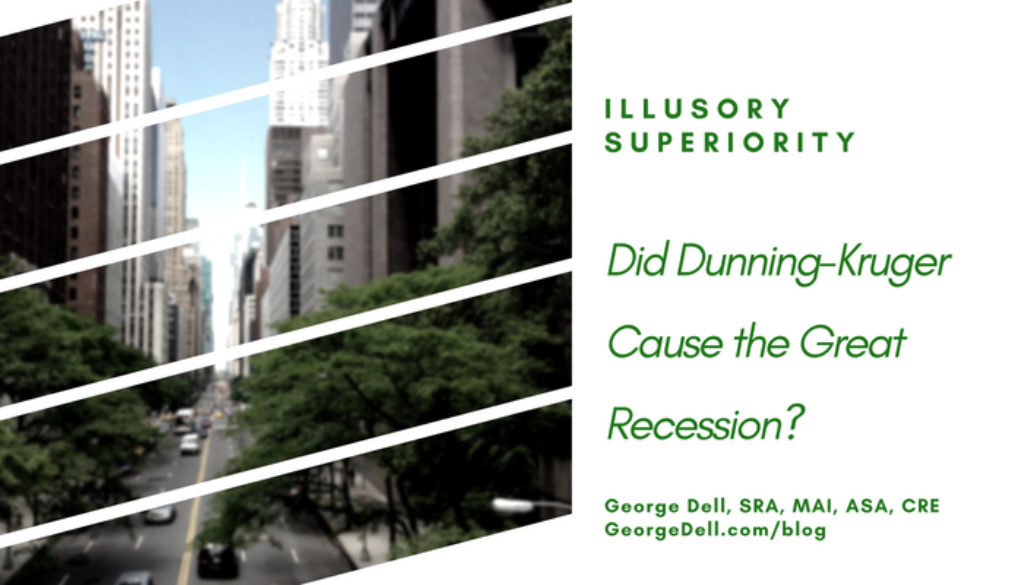We considered one cause of the Great Recession. This was the perversion of the very definition of the value. In the sociology of ‘groupthink’ (where the group is wrong, but everyone says it’s ok), Dunning-Kruger gave us another cause. (There are more to come – stay tuned!)
In a good world, a profession, legislators, administrators, and education would tell us that things had changed. That things were no longer as we hypothesized. They were not as we were taught. Not as we were trained. Not as our textbooks had assumed about the world. Things had changed. Some saw it coming. Most didn’t care.
So, what did Dunning-Kruger do? Well, they came up with a theory. In short, it states that people mistakenly assess their own rationality as superb. They have the education, the experience, and validation from years of practice doing the same thing.
The problem is they may have low ability to see, or even desire to see, what has changed. And things had changed. But Dunning-Kruger went on a level deeper. They said that most such people had little or no self-awareness, even blindness to the dramatic change.
Dunning-Kruger’s theory states that the cognitive bias of illusory superiority comes from the inability of low-ability people to recognize their lack of ability. In other words, You don’t know what you don’t know.”
Ironically, this error comes from the strong desire not be wrong! How can years of experience and status suddenly be less useful – even wrong?

It’s difficult to give up years of teaching, doing, and believing in the old solution. That alone can cause a mental block. It is a block to see or hear a new truth, even as it’s bearing down like a dragon, breathing deafening fire as we insulate ourselves with our “illusory superiority.”
Forbes Magazine, (Jan 24, 2017) described it as “a cognitive bias whereby people who are incompetent at something are unable to recognize their own incompetence. And not only do they fail to recognize their incompetence, they’re likely to feel confident that they actually are competent.”
This occurred as the groupthink around the definition of market value. It also occurred around the creation of many “statistical solutions” for valuation. A short list:
- The use of regression coefficients as adjustment amounts.
- The use of p-values and confidence intervals to ‘prove’ an appraisal model.
- The pretend random samples of hypothetical populations to get those p-values.
- Information loss causing time adjustments in the wrong direction. (The 1004mc)
- Similar loss of reliability by sticking with judgment-based partial-data selection.
- Sticking with three-to-six comps, even as USPAP (SR-1-4) states “an appraiser must analyze such comparable sales data as are available.”
Is it time to re-examine what we are doing and why do we do it?
Image credit: Erik de Haan, as shown in New York Times, August 15, 2018 Bleak New Estimates in Drug Epidemic: A Record 72,000 Overdose Deaths in 2017

February 18, 2019 @ 2:53 pm
Excellent article. And, excellent (if possibly incomplete) list of group think solutions.
May 18, 2021 @ 5:18 pm
I would think we are all guilty of illusionary superiority to some degree… and though it might create detrimental personality attributes for some, I think it might be a necessary component for self-esteem. That is, without self-esteem and thinking we might have some special ability(s) – – even if illusionary to a great degree – – we might lack the confidence needed to march our lives forward and help society progress.
On the other hand, Wikipedia stated that while illusionary superiority is associated with undeserved high self-esteem, people with legitimate high self-esteem do not necessarily exhibit it. Personally, I think most of the population (80%+) has some significant above average ability(s) in one form or another. Focusing on those with detrimental illusionary superiority – – I think it is likely many have reached “Peter’s Principle”; I.e., the demands of their job outstrip their ability to adequately perform; or are just plain dishonest people.
I think we can agree appraisal regression analysis as currently practiced with 3-9 comps “might” give you insight into one variable’s value, but multiple variables are going to require many comparables – – more in line with a mass appraisal in the imperfect real estate market; hence subjective judgment is used more than the true scientific method.
Lastly, I will question any “new truths” foundational underpinnings… if the new truth doesn’t pass muster, I don’t care what the new Zeitgeist is. Just because something has become the new status quo does not make right.. it merely becomes something we have to work around.
thanks
August 14, 2021 @ 5:15 pm
George, you asked where I fall on the graph… Like curiosity, honesty, respectfulness, hard work, and a propensity to engage; I believe a sense of humility should be a core component of one’s principles and perspective. That being said, I have legitimate self-esteem to the degree my accomplishments and achievements permit. I would like to think what I don’t know I can come to understand whether it be car repair, quantum physics, or appraising. George, may I ask where do you fall on the graph?
August 15, 2021 @ 3:27 pm
Thanks Michael,
Your one word “humility” is one I had difficulty with. No doubt, I have been at both ends of the curve, (perhaps at the exact same time) depending on the topic . . .
Finally, I found the definition of humility that just struck me as ideal: “knowing who and what I truly am, followed by an attempt to become that which I can be.”
I love the impact of the Dunning Kruger curve, because the mere awareness of it helps cope with my own biases and assumptions. Asking questions seems to always work better than giving answers (and opinions).